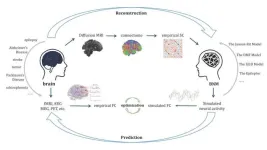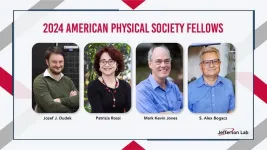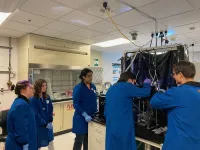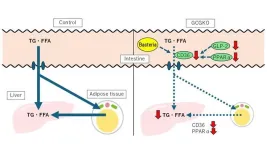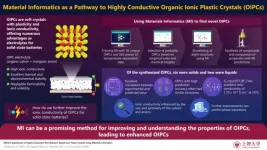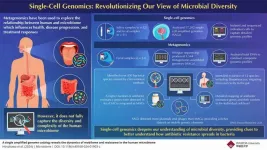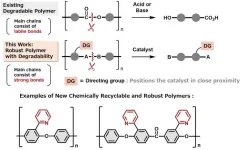(Press-News.org) With hundreds of observatories scattered throughout the world, there has never been a better time for astronomers to observe the infinite universe that lies beyond Earth. At any moment in time, a telescope pointed at the night sky can observe new transient phenomena, such as supernovae that brighten rapidly and then fade away over days to months, releasing massive amounts of energy in the process. These events are rare in any single galaxy and each gives researchers more insight into the dynamic time-domain sky.
But what if these observatories could work even closer together to view these important astronomical events?
The National Center for Supercomputing Applications and the Center for AstroPhysical Surveys (CAPS) received more than $2 million in funding from the U.S. National Science Foundation (NSF) to build a service that allows researchers to coordinate astronomical readings from observatories across the globe in near real-time.
“Our primary goal is to take some of the key facilities used by astrophysicists, operated by our colleagues at NSF NOIRLab and the Las Cumbres Observatory, and begin to integrate them into a shared ecosystem,” said CAPS Deputy Director Gautham Narayan. “From the scientist’s perspective, given a new astrophysical target, it’s important to be able to quickly understand what archival observations exist, what the currently available network of telescopes and instruments is, where they are and will soon be pointing to collect data, and who one ought to talk with to collaborate.
Once these two major facilities are fully supported, we can begin to broaden the ecosystem incrementally to further address the needs of multi-messenger astrophysics. This is a challenge of dealing with real-time big data from heterogeneous sources, which is our bread and butter at the Center for AstroPhysical Surveys.
Gautham Narayan, CAPS Deputy Director
The discovery and telescope follow-up of rare phenomena is critical to pushing the boundaries of fundamental physics and how scientists view and understand the universe. Multi-messenger time-domain astronomy is a powerful new tool for exploring the cosmos. The four messengers that astronomers study are light in all its forms, cosmic rays, neutrinos and gravitational waves, many of which change rapidly with time. It’s critical that observations of these messengers occur simultaneously or within a short time span so that astronomers capture their properties before the source changes.
However, it’s quite the challenge to coordinate community follow-up from multiple observatories across the globe – each with its own instruments – while minimizing duplication and maximizing the value of the combined dataset.
The proposed Hop-Enabled Real-time Observatory Information and Coordination (HEROIC) service from NCSA will provide the entire astrophysics community a single destination to quickly see what facility can point to a source, what the statuses of different instruments at that facility are, what archival data exists, what current weather conditions are, what observations are currently being scheduled or undertaken with them, and which groups to coordinate with. By collating, saving and publishing observatory and instrument status from a worldwide network of ground- and space-based facilities, HEROIC will be a central component in a fully integrated, interoperable cyberinfrastructure for astrophysics, where scientists can receive alerts, plan and trigger follow-up, and share observations with each other, breaking barriers between previously siloed facilities.
“If there is an interesting and extremely rare astrophysical source, say a possible pulsational pair-instability supernova, the community really needs to be able to coordinate rapidly and schedule follow-up observations,” said Narayan. “Right now, that happens through a mix of automated requests, waking up graduate students in the middle of the night and having them fill out arcane web forms or, in some instances, sending emails to observatory directors pleading for time. Even if a group is awarded some follow-up observations, astrophysicists don’t know – because they have no way to know – what other observations are being taken with different facilities at the same time. Fundamentally, this leads to duplication and waste.
“If we can enable groups to collaborate, we’d dramatically increase and improve the overall scientific output. HEROIC is about creating the capability for siloed facilities to interoperate, and provides scientists with an opportunity to collaborate that has the potential to revolutionize astrophysics in the big-data era.”
The tools provided through HEROIC are essential for all time-domain astrophysics and will enable entirely new studies. Scientists will be able to use existing facilities and archival data more effectively while also encouraging coordination between teams. By developing critical infrastructure that’s useful for multiple facilities, HEROIC also frees observatories from having to develop and maintain similar services themselves, reducing their development burden and increasing the incentive to participate.
“We’re incredibly fortunate to be able to collaborate with NSF NOIRLab and the Las Cumbres Observatory to build HEROIC incrementally,” said Narayan, the principal investigator for HEROIC. “They operate some of the best and most widely used telescopes in the world, and have some of the most experienced astrophysicists anywhere, with deep knowledge of the science and the facilities. By working closely with them, we can identify and fix key issues and build a useful and practical service that can be steadily extended to other missions.”
“Multi-messenger astronomy is one of the most exciting aspects of modern science and astronomers at NOIRLab are delighted to be joining the HEROIC project,” said Tom Matheson, NOIRLab astronomer and HEROIC project co-principal investigator. “NOIRLab staff will build the systems that let our telescopes share information, making our facilities among the first that HEROIC will use to provide astronomers worldwide with a comprehensive view of the resources available to them.”
The first NOIRLab telescopes that will be included in HEROIC are those that are most useful for multi-messenger follow-up — the NSF Víctor M. Blanco 4-meter Telescope at Cerro Tololo Inter-American Observatory, a Program of NSF NOIRLab, and the twin International Gemini Observatory telescopes, funded in part by the NSF and operated by NSF NOIRLab. Eventually, all NOIRLab-operated telescopes will be incorporated.
Las Cumbres Observatory, a global network of robotic telescopes specifically designed to observe rapidly changing astronomical events, is a co-recipient of the award.
“As a robotic observatory network, our computers and databases keep careful track of the availability of all of our telescopes and what they are doing,” said Andy Howell, senior staff scientist at Las Cumbres Observatory. “We’re excited to expand these tools to the rest of the astronomical community to make rapid and coordinated observations much more feasible.”
NCSA and CAPS are also part of the recently announced NSF-Simons AI Institute for the Sky or SkAI (pronounced “sky”) that will develop new artificial intelligence (AI) tools to advance astrophysics research and exploration of the universe. Projects like HEROIC and SkAI are at the intersection of astrophysics and AI.
“Building new hardware like telescope facilities and instruments is extraordinarily expensive and we are at the point where advances in cutting-edge science come from innovative software and innovative computing,” Narayan said. “We’re lucky to be able to draw on the computing expertise at NCSA, be it for deploying infrastructure in the cloud, using GPUs for large AI models or edge computing to reduce latency. I really value the freedom and creativity that gives us here at the University of Illinois to solve some of the hardest problems in astrophysics and cosmology.”
Check out the announcements from NSF NOIRLab and Las Cumbres Observatory for more information.
ABOUT ASPO/CAPS
NCSA’s Center for AstroPhysical Surveys (CAPS) brings cohesion and advancement to astrophysical survey science efforts across the University of Illinois Urbana-Champaign. CAPS offers annual postdoctoral and graduate fellowship programs, publishes vast amounts of astronomical data from a broad portfolio of astrophysical surveys and collaborates across disciplines to enable trailblazing research.
END
NCSA building stronger connections among observatories, astronomers
2024-10-07
ELSE PRESS RELEASES FROM THIS DATE:
Latest advances in brain network models for medical applications: A comprehensive review highlights future potential
2024-10-07
A research team from the International Research Institute for Artificial Intelligence at Harbin Institute of Technology, Shenzhen, has recently published a comprehensive review in the journal Health Data Science on the application of Brain Network Models (BNMs) in the medical field. This study summarizes recent advances and challenges in using BNMs to simulate brain activities, understand neuropathological mechanisms, evaluate therapeutic effects, and predict disease progression.
Brain Network Models ...
Jefferson Lab physicists named APS Fellows
2024-10-07
NEWPORT NEWS, VA – Four physicists affiliated with the U.S. Department of Energy’s Thomas Jefferson National Accelerator Facility have been selected by their peers for the distinct honor of Fellow of the American Physical Society.
“Our staff power the science and innovation that are continuing to move the discipline of physics and this laboratory into the future,” said Jefferson Lab Director Kim Sawyer. “We’re very proud that the accomplishments and contributions of these four Jefferson Lab staff members to the field of physics are being recognized by their peers with this honor.”
According to the APS, fellows have made ...
Bias found when drug manufacturers fund clinical trials
2024-10-07
COLUMBUS, Ohio – Psychiatric drugs are reported to be about 50% more effective in clinical trials funded by the drug’s manufacturer than when trials of the same drug are sponsored by other groups, new research shows.
While many studies have found more favorable results for drugs in clinical trials funded by their manufacturers, these studies normally just compare a set of manufacturer-funded studies with a set of studies funded in other ways, said Tamar Oostrom, assistant professor of economics at The Ohio State University, who conducted this new research.
This ...
The University of Texas at San Antonio is advancing space exploration as the lead of a multimillion-dollar DOE project
2024-10-07
UTSA was selected by the U.S. Department of Energy’s (DOE) Office of Nuclear Energy (NE) to lead a multimillion-dollar project that will stimulate nuclear energy research at UTSA, leverage novel experimental data to bolster computational efforts at the university, and provide professional training to prepare undergraduate and graduate students for careers in nuclear energy science. UTSA researchers will collaborate with a leading nuclear energy laboratory as well as across academic institutions.
The award is part of the DOE’s Nuclear Energy University Program’s Integrated Research Projects (IRPs). These projects aim to provide research and development solutions ...
Gut hormones could hold the key to fighting fatty liver disease
2024-10-07
The accumulation of fats in the liver is driven by high-fat diets and obesity, and is becoming an increasingly prevalent global health concern. Characterized by excessive fat accumulation in the liver, this condition poses significant risks for various metabolic disorders. While much of the existing research has focused on fat metabolism within the liver itself, emerging findings emphasize the critical role of the gut in this complex process. Proglucagon-derived peptides (PGDPs), including glucagon, GLP-1, and GLP-2, are known to be the key hormones that regulate lipid metabolism in the liver. Derived from the same precursor—proglucagon, previous studies ...
Material informatics for the development of high-performance solid electrolytes in rechargeable batteries
2024-10-07
The surge in the adoption of renewable energy, coupled with the rapid growth of the electric vehicle market in recent years has significantly increased the demand for high-performance, all-solid-state batteries. Compared to conventional liquid electrolyte-based batteries, solid-state batteries offer higher energy density, improved safety, longer lifespan, and reliable operation over a wide temperature range. However, there are still challenges to their widespread applications, including low ionic conductivity, high interfacial resistance, and the presence of particle-particle interfaces in the electrolyte, which leads to increased resistance and lower energy density.
Notably, ...
Decoding bacterial genomes using single-cell genomics
2024-10-07
The human microbiome plays a critical role in our health, influencing everything from disease development to treatment responses. This connection has captured the attention of scientists worldwide, eager to unlock its secrets. While traditional metagenomics has provided valuable insights, it falls short in resolving microbial diversity at the strain level and accurately profiling genes involved in antibiotic resistance. These limitations highlight the need for more advanced approaches.
To address this, a team of researchers led by Associate Professor Masahito Hosokawa, from Waseda University, in collaboration with bitBiome, Inc., developed a groundbreaking single-cell ...
Unexpected intellectual friendships, like Plato and Aristotle, are the secret of long-term innovation, finds prize-winning US academic
2024-10-07
The winner of one of the UK’s biggest academic prizes has discovered what he believes is the key to long-term innovation and economic growth: unplanned intellectual friendships – like Greek philosophers Plato and Aristotle, or DNA pioneers James Watson and Francis Crick.
Professor Kirk Doran, an Associate Professor of Economics at the University of Notre Dame in Indiana in the United States, has been researching what drives innovation for 14 years – and has made his discovery by forensically analysing data including published research and census, tax, migration and historical data.
Professor Doran has ...
Aussies above 50 are living longer, while younger people are suffering
2024-10-07
Australians under 50 are experiencing stagnating life expectancy while older cohorts, especially men, are living longer, according to new research from The Australian National University (ANU).
The study examined longevity trends and patterns in six English-speaking countries (Australia, Canada, Ireland, New Zealand, the United Kingdom and the United States) and compared them with other high-income countries.
The results show striking similarities between English-speaking countries in terms of adverse health outcomes for young and middle-aged adults under fifty.
Lead author and ANU demographer, Dr Sergey Timonin, said the study ...
New polymer design breaks the tradeoff between toughness and recyclability
2024-10-07
Osaka, Japan – Plastics underpin much of modern life—areas like medicine, technology, and food safety would be unrecognizable without plastics and their useful properties. However, the toughness of plastics, which is often desirable, also makes them a dangerous pollutant and difficult to recycle. The solution to this serious and growing problem is making plastics easier to recycle.
In a study recently published in Chemical Science, researchers at Osaka University have found a way to make tough, high-performance polymers, the main component of plastics, that can be broken down easily and precisely into their component parts and ...
